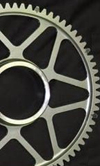Cryogenic metal treatments
 There is a vast array of metallic materials of all kinds whose mechanical properties are improved by heat treatment. Steels are commonly raised to high temperatures, quenched and subsequently tempered by raising the temperature to a carefully controlled level and maintained there for a known amount of time; aluminium and titanium alloys are often solution-treated by heating to a given temperature before quenching and age-hardening by heating. In the case of most steels after quenching, the steel is brittle, and tempering softens the material and gives it a level of ductility. Aluminium alloys after quenching are soft; the ageing treatment increases strength and hardness.
There is a vast array of metallic materials of all kinds whose mechanical properties are improved by heat treatment. Steels are commonly raised to high temperatures, quenched and subsequently tempered by raising the temperature to a carefully controlled level and maintained there for a known amount of time; aluminium and titanium alloys are often solution-treated by heating to a given temperature before quenching and age-hardening by heating. In the case of most steels after quenching, the steel is brittle, and tempering softens the material and gives it a level of ductility. Aluminium alloys after quenching are soft; the ageing treatment increases strength and hardness.
All these processes involve raising the temperature of the material more than once. However, there is a process in which the temperature of the material is lowered markedly and again there is an improvement in its properties. Cryogenic treatments are commonly specified as part of the 'harden and temper' treatments for special tool steels. When a steel is raised to high temperature (the austenitising temperature) before quenching, the material is in a form known as 'austenite', and on quenching, this is transformed to another 'phase' called martensite. Tempering improves the ductility of martensite.
However, within many highly alloyed steels, there is an amount of austenite that isn't transformed to martensite. Austenite is, in most cases (with the exception of special austenitic steels), not a stable phase at the temperatures at which we will use the steel and will, over time, transform to other phases. By cryogenic treatment, we can transform nearly all of this 'retained austenite' to martensite. This is only necessary with steels where the proportion of retained austenite is significant.
There is good evidence though to suggest that cryogenic treatments have a number of other benefits, including improving the wear resistance and fatigue behaviour of steels. Metallographic examination of cryogenically treated steels reveals a network of finely dispersed carbides within the steel matrix. The cryogenic treatment is responsible for the precipitation of these carbides, which have been shown to improve wear resistance.
Cryogenic treatments are also known to provide a degree of stress relief; this might seem counter-intuitive when we are used to 'conventional' thermal stress relief treatments being carried out at elevated temperatures. The technique of 'uphill' or reverse quenching is known to provide effective relief of stresses in aluminium castings. In this process, a casting (or other components with unfavourable residual stresses) is cooled using liquid nitrogen - or, more often, the evaporated vapours of liquid nitrogen - and then moved to a steam chamber where the parts are reverse quenched using high-velocity steam.
Cryogenic treatments - whether they are aimed at changing the structure of the material through more complete transformation of austenite to martensite, carbide precipitation or relief of unfavourable stresses - are known to improve fatigue life/strength.
As John Stowe pointed out in his cryogenic treatment article in Race Engine Technology (issue 28, February 2008), there is an increasing acceptance of cryogenic methods in racing, and this is right across the field of motorsport, from 'grassroots' clubmen to the top racing teams. Some people dismiss cryogenic treatments as hocus-pocus or voodoo, but they are generally ignorant of the facts, many of which are widely available in peer-reviewed journals.
Equally, however, there are a lot of unsubstantiated claims for improvements which, when queried, aren't backed up by any data. If these claims aren't based on data, then the basic idea is quite likely to be true - for example, a gain in fatigue life or wear resistance - but you will need to judge the effectiveness for yourselves.
Fig. 1 - Carburised gears are a popular application for cryogenic treatments
Written by Wayne Ward